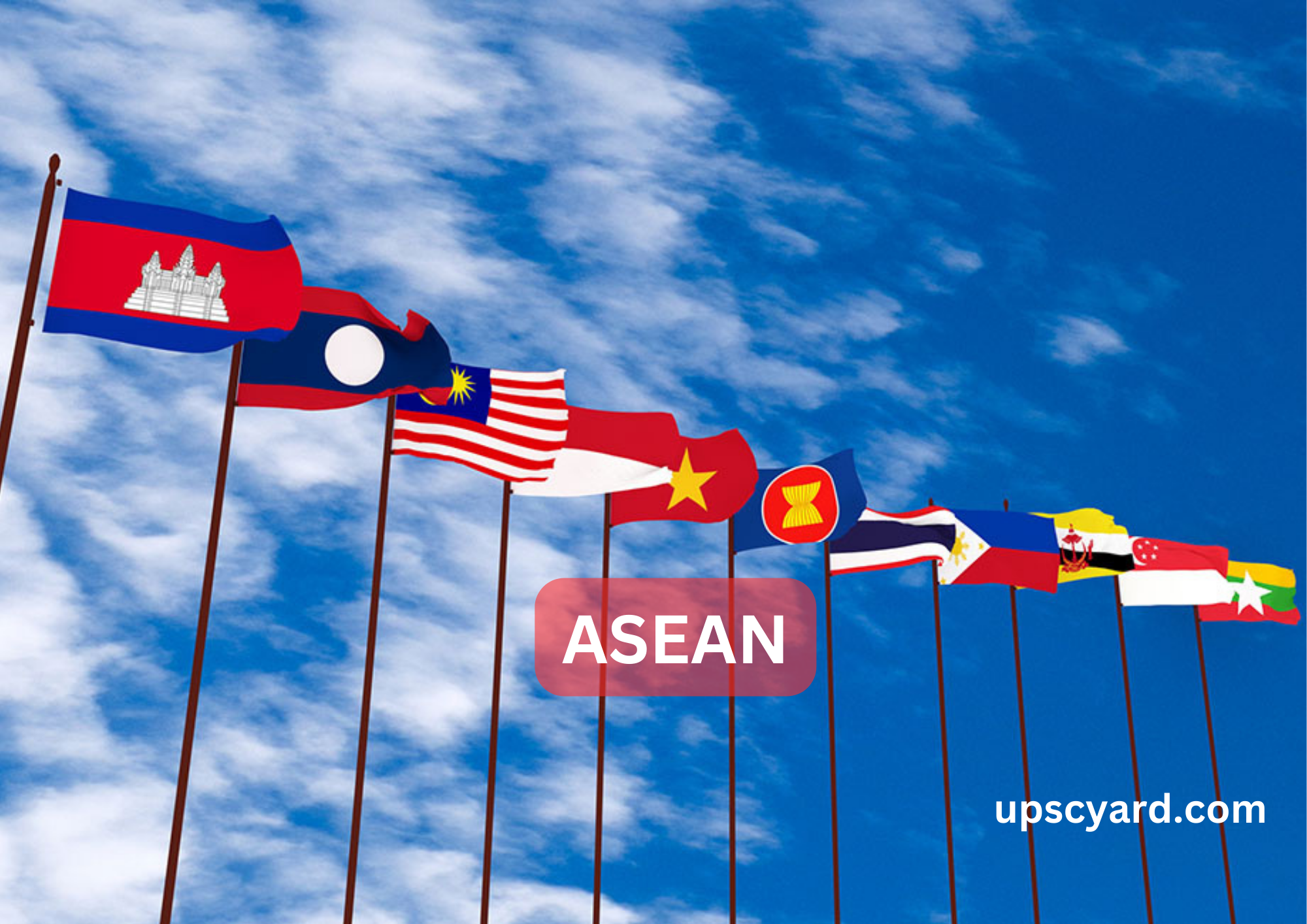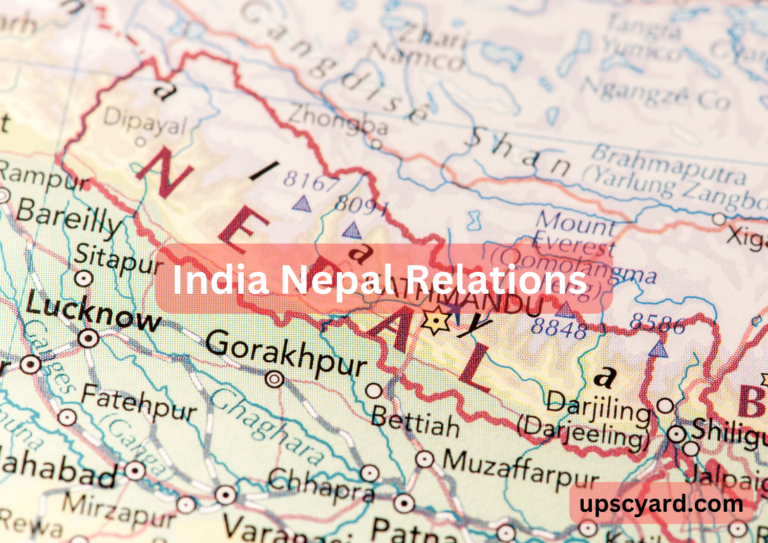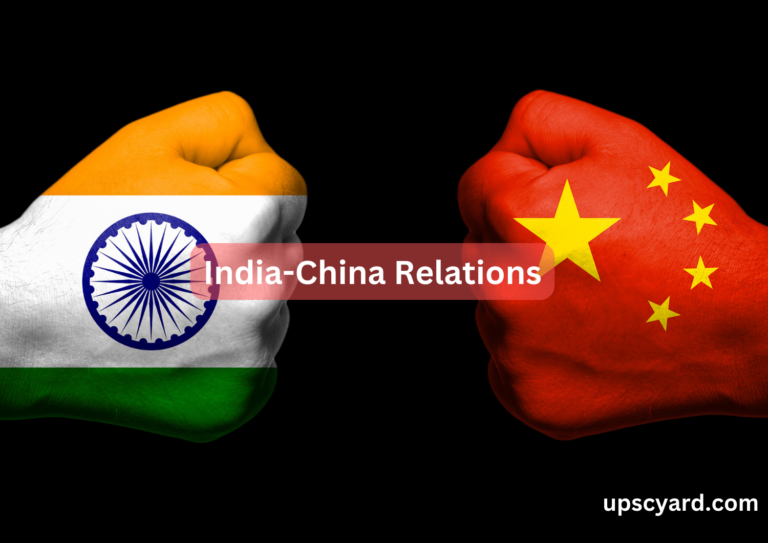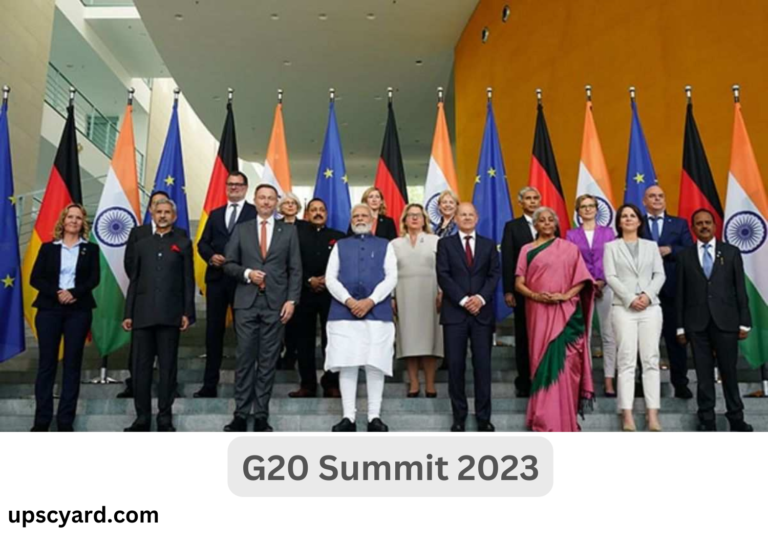ASEAN, short for the Association of South-East Asian Nations, comprises 10 member countries and was established in 1967. Its headquarters are situated in Jakarta, Indonesia. The member nations, all geographically located in South-East Asia, include Myanmar, Thailand, Malaysia, Singapore, Cambodia, Laos, Indonesia, Philippines, Vietnam, and Brunei.
The organization’s motto is “One Vision, One Identity, One Community,” and its primary objective has consistently revolved around promoting economic and social development within the region and beyond.
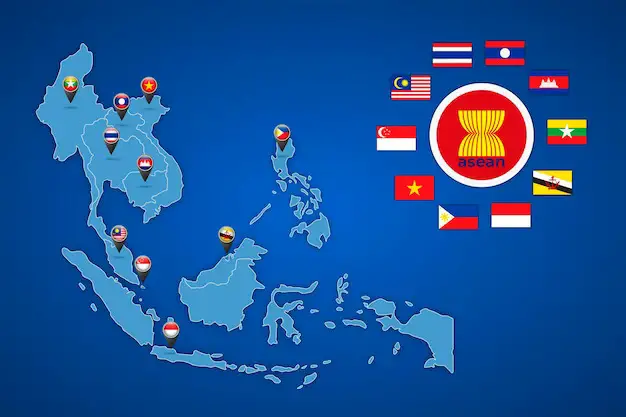
ASEAN holds significant Global Importance
- Economic Significance: The combined GDP of these 10 nations exceeds USD 3 trillion, slightly surpassing India. Furthermore, they have consistently achieved an impressive annual GDP growth rate of nearly 5%.
- Demographic Strength: ASEAN boasts a collective population of around 600 million people, positioning it ahead of the European Union and the United States, although still behind China and India in terms of population size.
- Trade Powerhouse: On the global stage, ASEAN countries contribute to over 7% of global exports, focusing on advanced and high-end manufacturing.
- Strategic Location: Geographically, ASEAN occupies a pivotal position, nestled between the Indian Ocean Region and the Pacific Ocean region. These two oceans are responsible for facilitating over 70% of global maritime commerce and 65% of global oil supplies, making this region geopolitically significant.
- Stability and Peace: ASEAN has played a vital role in maintaining regional stability and peace.
India’s relationship with ASEAN
India’s relationship with ASEAN holds a pivotal role in its foreign policy. This connection has undergone significant evolution, starting with the inception of the ‘Look East Policy’ in the early 1990s. This policy laid the groundwork for India’s gradual involvement with ASEAN, evolving from Sectoral Partner status in 1992 to becoming a Dialogue Partner in 1996 and finally achieving Summit-level Partner status in 2002.
The India-ASEAN Strategic Partnership gained renewed vigor with the introduction of the “Act-East Policy” in 2014. This policy signified India’s clear intent to elevate its engagement with the member states of ASEAN.
The Act-East Policy places a strong emphasis on the three core elements known as the “3 C’s” – Connectivity, Commerce, and Culture. These areas serve as focal points for enhancing integration between ASEAN and India.
Significance of ASEAN for India
The significance of ASEAN for India is multifaceted:
- Economic Collaboration: ASEAN ranks as India’s fourth-largest trading partner. Notably, Singapore has become a major source of Foreign Direct Investment (FDI) in India.
- Security Cooperation: ASEAN has seen the emergence of various terror groups like Jemaah Islamiyah and the Islamic State. Collaborative efforts with India on security and cyber security matters can foster a safer environment for both regions.
- Economic Partnership: ASEAN nations seek to build a sustainable economic partnership with India, capitalizing on India’s demographic dividend. India is poised to become a hub for manufacturing and shipping, benefiting the entire region.
- Indian Diaspora: Approximately 6 million members of the Indian diaspora reside in ASEAN countries, serving as vital connections. Many have assumed influential roles in government and business, such as KC Shanmugam, the Home Minister of Singapore, and Tony Fernandez, the head of Air Asia in Malaysia.
- International Rules-Based Order: ASEAN nations aspire to collaborate with India in upholding a rules-based international order, particularly in the South China Sea, as a response to Chinese assertiveness.
- Connectivity Projects: Collaborative connectivity projects with ASEAN can drive development and prosperity in India’s North-Eastern region.
India’s Collaboration with ASEAN
Trade & Economic Cooperation: The ASEAN-India Trade in Goods Agreement (2009) and agreements on Trade-in-Services and Investments (2015) solidify economic ties. Bilateral trade surpasses USD 80 billion, constituting about 10.6% of India’s total trade.
Connectivity: Enhancing connectivity, both land and sea, is a strategic goal. The India-Myanmar-Thailand highway, nearing completion, is set to extend into neighboring countries, including Laos, Cambodia, and Vietnam. The Kaladan Multimodal connectivity project with Myanmar is another vital initiative.
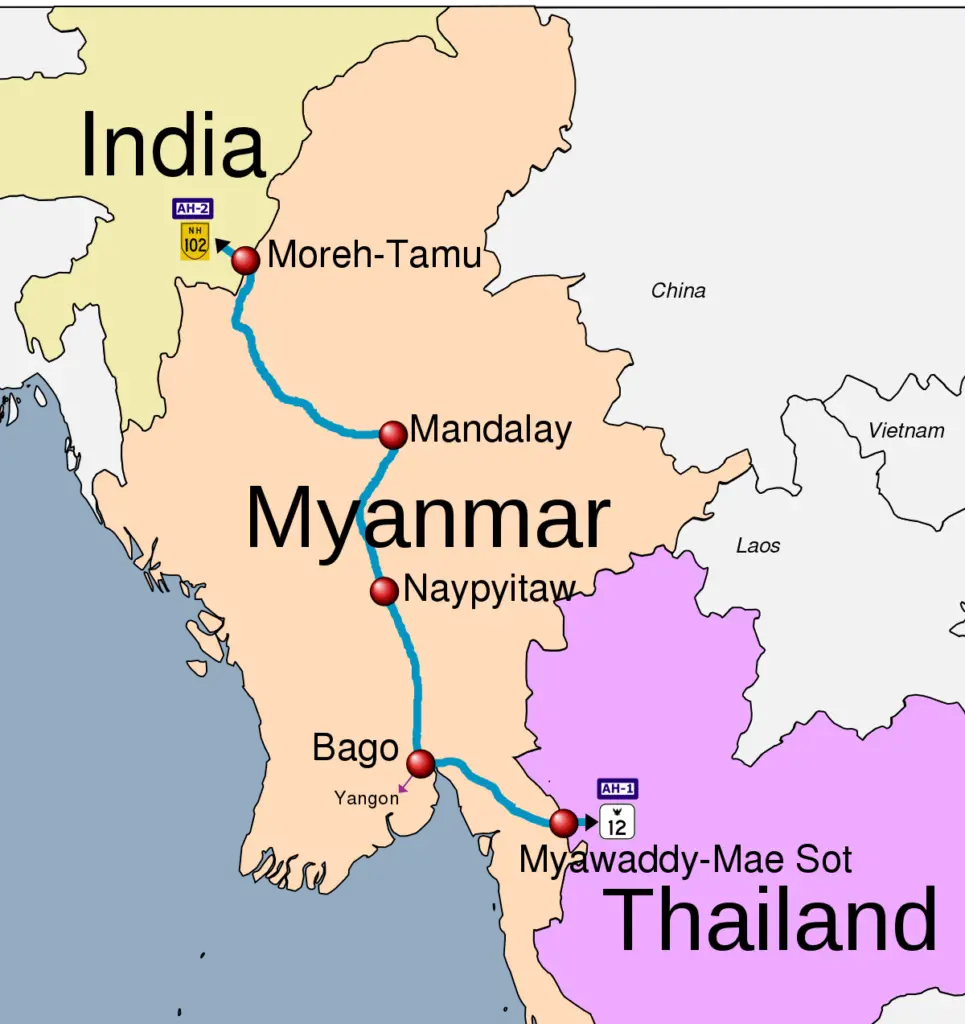
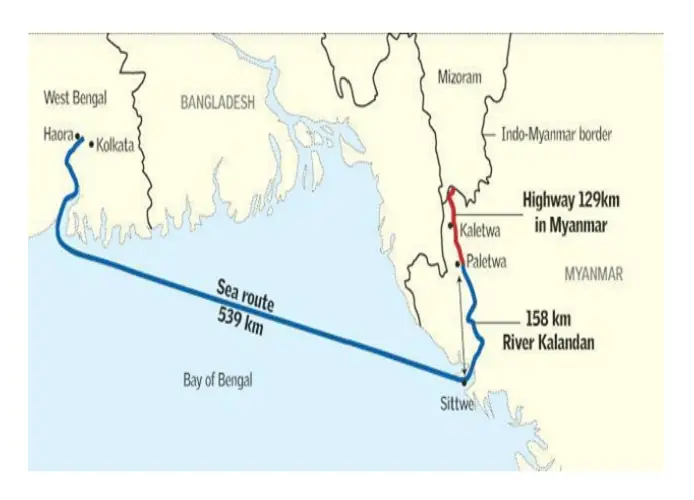
Investment: ASEAN contributes significantly to Foreign Direct Investment (FDI) in India, representing 18% of cumulative inflows. Over the past decade, India has invested around USD 40 billion in ASEAN countries.
Strategic Partnership: India’s journey with ASEAN began in 1993 as a ‘sectoral dialogue’ partner and evolved into a ‘Strategic Partnership’ in 2004. Maritime cooperation is a crucial aspect, aligning India with ASEAN nations in supporting a rule-based international order, particularly concerning China.
New & Renewable Energy: Recent agreements underscore ASEAN-India cooperation in renewable energy.
Agriculture: Cooperation spans food security, technology exchange, research, development projects, and human resource development. Annual ASEAN-India Agriculture Ministers Meetings (AIMMAF) have been held since 2011.
Funding Commitments: ASEAN has pledged funds for various purposes, including the ASEAN-India Cooperation Fund, ASEAN-India Development Fund, and ASEAN-India Green Fund for renewable energy projects.
Cultural Exchange: Events like the 4th International Dharma-Dhamma Conference foster cultural connections.
People-to-People Connectivity: Numerous projects, including the ASEAN-India Network of Think Tanks, a Student Exchange Programme, and a Media Exchange Programme, promote interactions and understanding between India and ASEAN countries.
The ASEAN bloc encounters several challenges:
- Diverse Development Levels: ASEAN comprises nations at varying levels of development. Singapore stands as a developed and prosperous member, while others like Myanmar are still progressing on the path of development.
- Internal Disputes: Internal disputes, such as the Rohingya refugee crisis, have caused divisions within the bloc. Unfortunately, ASEAN lacks an effective dispute resolution mechanism to address such issues.
- Divergence on China: The bloc’s stance on China remains divided. While aggressive Chinese actions have partially united ASEAN, some countries like Cambodia continue to support China.
- Uneven Economic Agreements: ASEAN’s economic agreements with China have not always been beneficial to its member nations. Many of these agreements predominantly favor China, creating economic imbalances.
- Trade Imbalance and Visa Regime: Trade imbalances, particularly unfavorable to India, have arisen. India’s efforts to negotiate agreements, like the one concerning liberalizing visa regimes, have faced opposition, creating uncertainty. India has also announced a review of all its Free Trade Agreements (FTAs), contributing to the uncertainty.
- RCEP Exit: India’s decision to withdraw from the Regional Comprehensive Economic Partnership (RCEP) has strained relations with ASEAN, leading to differences.
Recent developments in the ASEAN region
- Regional Comprehensive Economic Partnership (RCEP): ASEAN, along with five of its free trade partners (China, Japan, South Korea, Australia, and New Zealand), signed the RCEP. This agreement is seen as having the potential to stimulate global economic recovery. However, questions remain about its fairness and whether it might be dominated by China, given the significant trade between ASEAN and China, which exceeds USD 450 billion.
- ASEAN’s Stand Against China: In June 2020, ASEAN members collectively criticized China’s construction of artificial islands in the South China Sea and its lack of transparency regarding the COVID-19 pandemic. Such issues are addressed in the Annual Track 1.5 dialogue between the parties.
- Shift to “Indo-Pacific”: The USA’s shift from using “Asia-Pacific” to “Indo-Pacific” underscores India’s increasing importance in the region. This shift aligns with India’s ‘Asia-Pacific’ policy, emphasizing the significance of cooperation with ASEAN.
- Cultural Engagement: India is involved in the restoration of Pagodas and temples in Myanmar and Cambodia, preserving historical and cultural ties with these nations.
- Diaspora Significance: India values its diaspora, which plays a crucial role in maintaining historical connections with ASEAN countries.
- Economic Negotiations: India needs to address its economic disagreements with ASEAN within the RCEP framework and secure more favorable terms. Active regional engagement and providing security assurances to ASEAN nations are also essential.
- Cooperation Agreements: Recent virtual meetings have led to agreements between India and ASEAN nations to cooperate in addressing post-COVID-19 challenges and develop a new framework agreement for the next five years, building a sustainable future.
Mains Questions PYQ
Q. Evaluate the economic and strategic dimensions of India’s Look East Policy in the context of the post-Cold War international scenario. 2016 (15)
Q. Indian Diaspora has an important role to play in South East Asian countries’ economy and society. Appraise the role of Indian Diaspora in South-East Asia in this context. (2017) 15

